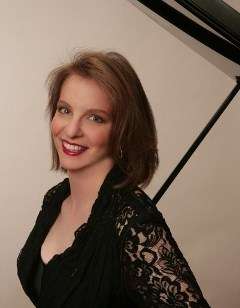|
Back
American Cuisine in Cincinnati Cincinnati
Music Hall
04/25/2014 - & April 26*, 2014
Samuel Barber: Adagio for Strings in B-flat Minor
Leonard Bernstein: Three Dance Episodes from “On the Town” – Symphony No. 2 (“The Age of Anxiety”)
Steven Mackey: Stumble to Grace
Orli Shaham (piano)
Cincinnati Symphony Orchestra, David Robertson (Guest Conductor)

O. Shaham (Courtesy of CSO)
American music was the theme of Saturday’s concert by the Cincinnati Symphony Orchestra at Music Hall. There were works by Leonard Bernstein, Samuel Barber and Steven Mackey. Mackey was represented by his 2011 piano concerto Stumble to Grace, a CSO premiere. Also on the program were Bernstein’s Three Dance Episodes from “On the Town”, and his Symphony No. 2, “The Age of Anxiety”. Both featured pianist Orli Shaham. Prefacing “The Age of Anxiety” was Barber’s Adagio for Strings. The CSO was led by guest conductor David Robertson in his overdue CSO debut.
Robertson, music director of the St. Louis Symphony Orchestra as well as chief conductor and artistic director of the Sydney (Australia) Symphony Orchestra, opened the concert with a Technicolor performance of Bernstein’s Dance Episodes. “The Great Lover,” “Lonely Town” and “Times Square” have never sounded so crisp, bright and energetic – or so melancholy (“Lonely Town”). Solo contributions by the CSO were outstanding, among them Doug Lindsay on trumpet (“Lonely Town”) and Ben Freimuth and James Bunte, on E-flat clarinet and alto saxophone, respectively (“Times Square”).
Mackey wrote his Stumble to Grace for Orli Shaham, and she premiered it with Robertson and the St. Louis Symphony in 2011. Mackey’s inspiration, he says, was watching his son learn to walk. He has conceived it in five “Stages,” analogous to the stages of childhood development. It opens with a little celeste tune and lots of colorful percussion, as the child (the piano) “stumbles” over the keys. By Stage Two, the writing is full and luxurious, as the piano plays an ever greater part in the texture. Stage Three begins softly and gently with the piano alone, before becoming rambunctious with the full orchestra. After a more peaceful Stage Four, the concerto closes with Stage Five, where the piano is jazzy, self-assured and on equal terms with the orchestra. A loud police whistle heard near the end signals the conclusion, which was almost shattering. In all of this, Shaham worked hand in glove with Robertson and the CSO, drawing an enthusiastic response from the audience.
Bernstein’s 1949 “Age of Anxiety” is part concerto and part symphony, with a central role played by the piano. Bernstein based it on W.H. Auden’s 1946 poem of the same name about three men and a woman who meet in a bar and spend the rest of the evening discoursing on the meaning of their lives. The work was particularly well placed, following Barber’s Adagio for Strings, which Robertson gave an extremely moving reading. He took it very slowly, with minimal or no vibrato by the strings at times, and built to a ringing climax, seemingly setting the stage for Bernstein’s spiritual exploration, which followed.
From the forlorn clarinets at the beginning, Bernstein’s Symphony emerged like a true conversation in Robertson’s hands. The way the fourteen variations in Part One followed one upon another, each picking up a strand of what went before, was almost programmatic. Shaham played her role with great skill, lending force and expression to the ongoing dialogue. Part Two, beginning with the Dirge, which envisions a cab ride to the woman’s apartment, was very dramatic. The Masque, which takes place in her apartment, was vibrant and jazzy, with a built-in blues song. The music grew quite virtuosic for the piano and made a stunning impression before it was interrupted by offstage piano, which segued into the Epilogue.
The characters’ search for faith takes place in the Epilogue, which Robertson gave perfect shaping. Its chorale-like aspect took hold right away, warming to an affirmative, major-mode conclusion, which drew the audience to their feet in a unanimous ovation.
Mary Ellyn Hutton
|